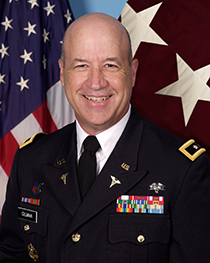News Briefs
New CEO for NIH Clinical Center
Introducing James Gilman, M.D.

James K. Gilman, new CEO for the NIH Clinical Center.
NIH Director Francis S. Collins announced the selection of Major General James K. Gilman, U.S. Army (Retired), as the inaugural chief executive officer (CEO) of the NIH Clinical Center. Gilman joined NIH in early January 2017.
“Dr. Gilman is a cardiologist and highly decorated leader with rich experience in commanding the operations of numerous hospital systems,” said Collins. “His medical expertise and military leadership will serve the NIH Clinical Center well as it continues to strive for world-class patient care and research excellence.”
As CEO, Gilman will oversee the day-to-day operations and management of the 200-bed, 870,000-square-foot research center on NIH’s Bethesda campus. Last year, the Clinical Center had approximately 6,000 inpatient admissions and 100,000 outpatient visits. Every patient at the Clinical Center is on a research protocol. Gilman will guide the performance of the Clinical Center, focusing particularly on setting a high bar for patient safety and quality of care, including the development of new hospital operations policies.
Gilman served 35 years in the U.S. Army, most recently as commanding general of the U.S. Army Medical Research and Materiel Command, Fort Detrick (Frederick, Maryland). He led several Army hospitals during his long career—Brooke Army Medical Center (Fort Sam Houston, Texas); Walter Reed Health Care System (Washington, D.C.); and Bassett Army Community Hospital (Fort Wainwright, Alaska). He also served as Director of Health Policy and Services in the Office of the Surgeon General, U.S. Army Medical Command, where he was responsible for all aspects of professional activities and health-care policy. Gilman has received numerous military awards and decorations, among them the Distinguished Service Medal, the Legion of Merit, and the Meritorious Service Medal.
Gilman holds a bachelor of science in biological engineering from Rose-Hulman Institute of Technology (Terre Haute, Indiana) and received his M.D. from the Indiana University School of Medicine (Indianapolis). He completed a residency in internal medicine and a fellowship in cardiovascular diseases at Brooke Army Medical Center, where he later became chief of cardiology and was responsible for training cardiology fellows. He is board certified in internal medicine with a subspecialty in cardiovascular disease.
After his retirement from the U.S. Army in 2013, Gilman served as executive director of Johns Hopkins Military and Veterans Institute in Baltimore until June 2016.
“I especially want to thank Dr. John Gallin who, after many years as Clinical Center director, has taken on the new role of NIH associate director for Clinical Research and chief scientific officer,” said Collins. “This critical position is essential to ensuring that NIH continue its record of extraordinary scientific accomplishments in a world-class research setting.”
Seriously Big Tanks
New Water-Storage and Thermal-Energy Systems

CREDIT: NIH RECORD
Rendering of two new cylindrical water tanks that will serve NIH’s Bethesda campus (view from the west).
Construction began on March 1, 2016, on an industrial water-storage (IWS) system and a thermal-energy storage (TES) system—both on the south side of campus—that will greatly increase the efficiency and reliability of the NIH Central Utility Plant (CUP). The projects are intended to ensure that NIH research and patient care can continue uninterrupted if there is an unexpected power outage or disruption in public utility services.
Large research campuses such as NIH require a reliable chilled water supply to control building temperature and humidity to rigorous specifications and to operate critical equipment. Without this ability, many NIH functions would have to be curtailed. Currently, the Washington Suburban Sanitary Commission supplies water to NIH.
In December 2008, a 66-inch water main broke beneath the 8500 block of River Road in Carderock, Maryland. This caused NIH to experience low water pressure. The event prompted the Office of Research Facilities to commission a study of NIH’s water needs in case of future disruptions. The study recommended that NIH expand its water-storage capacity to ensure the availability of chilled water at all times. The two new systems, under the supervision of Gias Ahmad (Office of Research Facilities), will serve this purpose.
The IWS system includes a 5-million-gallon water tank at parking lot 41 and will supplement the existing 5,000-ton chillers and cooling towers in the CUP. The tank, 65 feet high and 120 feet in diameter, will increase water capacity and provide a backup for chilled feed water to offset evaporation. It will also provide boiler feed water. The IWS system will allow NIH to meet the need for water for a few days if a water-supply interruption occurs, ensuring reliable cooling and heating to campus buildings.
Construction is also underway for a second, larger water facility, the TES system, on the Building 34 site. It will hold 8 million gallons of chilled water and stand 100 feet high, with the same diameter as the IWS tank. Building 34, the old campus utility plant, will be demolished. Construction on both the IWS and the TES systems is expected to be completed by October 2017.
Thermal storage is a low-cost, highly efficient form of energy storage. Combined with other energy sources, thermal storage provides a green tool that can help in achieving Leadership in Energy and Environmental Design certification for the building or facility owner. Off-peak energy consumption (power used during the night) can be used to meet on-peak demand (power used during the day) by producing an energy source locally at night when it is more efficient and cheaper to generate and using it during peak demand. Utility companies charge more for on-peak power consumption than for off-peak power consumption and also charge for peak power use. Thus, TES helps reduce peak power demand.
Other advantages of thermal storage include:
- Reduced utility-bill peak demand resulting in decreased electrical costs
- Reduced strain on the power grid—using nighttime energy balances the distribution of energy needs 24 hours a day so there isn’t as much peak demand during the daytime
- Reduced energy consumption
NIH’s cooling load is one of NIH’s largest single utility costs. When combined with buildings’ energy use, the time of peak cooling energy needs produces the highest electrical demand. That peak electrical demand is not only costly to NIH, but also creates challenges for the electric utility serving campus. Adding chilled-water thermal storage can make existing chillers serve a far greater load than the installed equipment capacity.
To read the full article in the NIH Record, go to https://nihrecord.nih.gov/newsletters/2016/03_11_2016/story4.htm.
This page was last updated on Monday, April 11, 2022
